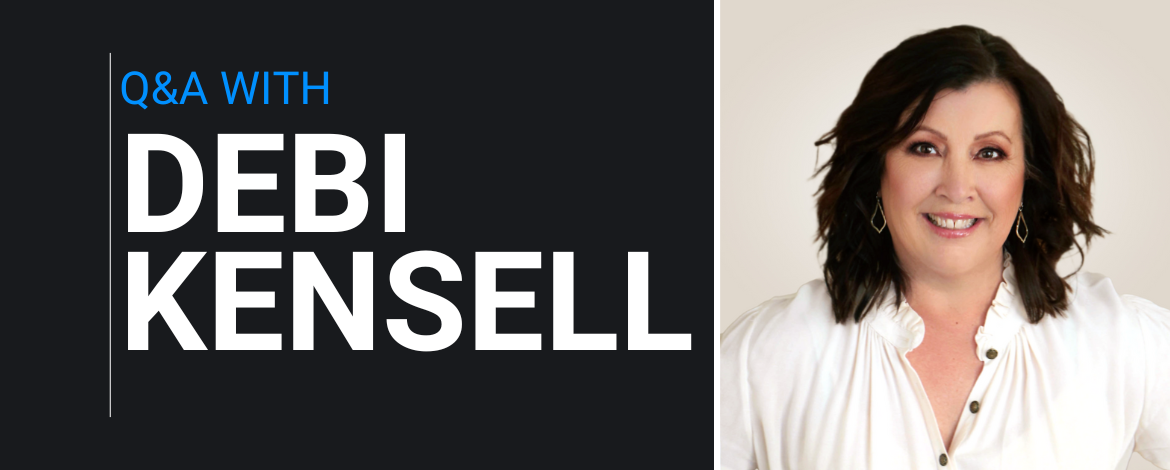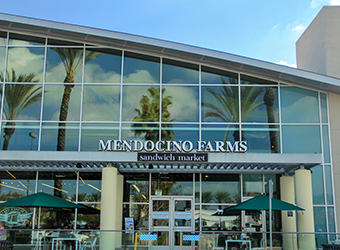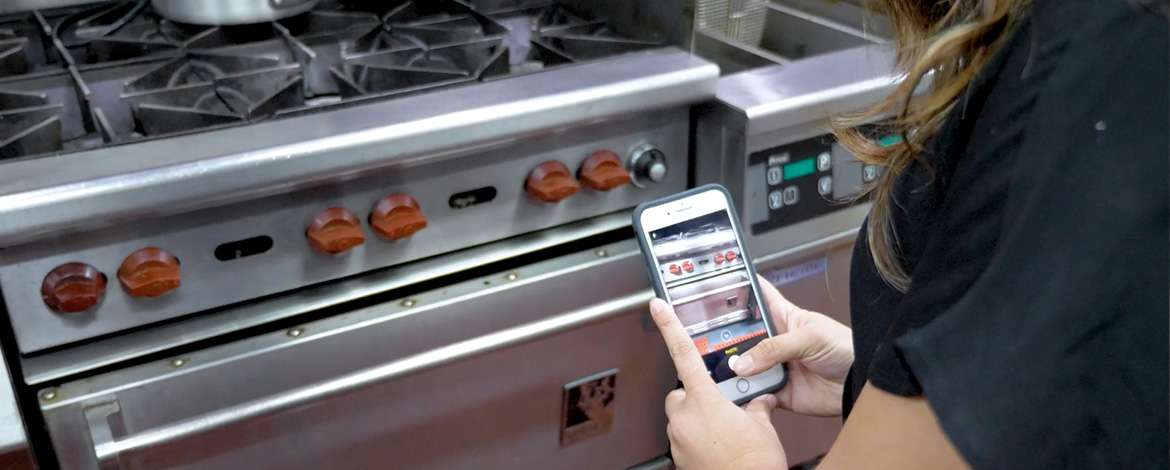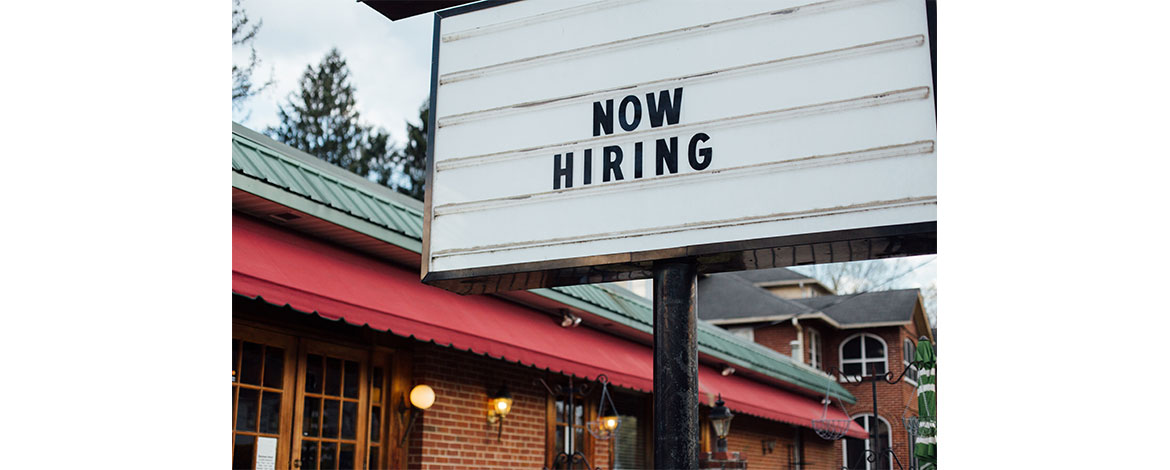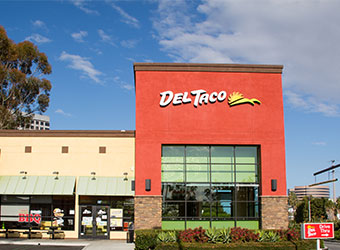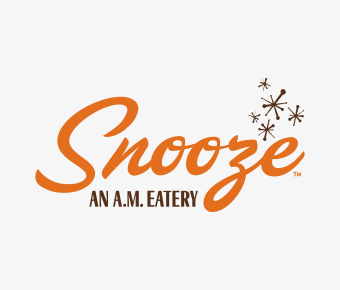Today she’s the Executive Director and CEO of the Restaurant Facility Management Association, but this mosaic-loving, former graphics designer in the oil business and grandmother of two has forged a fascinating, circuitous path to get here. We sat down with Debi Kensell, Executive Director & CEO of the Restaurant Facility Management Association (RFMA) to reflect on her career path and current leadership role at RFMA. Read the full interview below.
Tell us about RFMA and your current role.
RFMA was established in 2004 by a group of restaurateurs that believed there was a unique need of education in restaurant facilities to warrant a standalone association. RFMA was created to do just that, educate, and provide opportunities for members to build relationships with industry partners coming together to network about facilities and vendor needs.
What are the mission and goals of RFMA?
Our mission is to equip restaurant facility professionals to advance their careers and organizations. Our goal is primarily to elevate their status within their companies and within their industry peers. When I started in the association world of facilities there were very few high-level positions within the facilities departments. Today we see VP’s of facilities throughout our restaurant member companies.
How many members does RFMA have?
Over 1450 individual members representing over 250 restaurant brands; we have over 400 vendor companies.
What are some of the benefits of being a RFMA member?
The biggest benefit is building your restaurant facilities network when you join the RFMA family. Members receive free education through webinars and the CRFP Prep Course as well as discounted rates for the CRFP exam and meeting registrations. Each member receives the Facilitator, the official association magazine. We have a weekly newsletter called the Dish to keep members aware of upcoming events and opportunities. As a member they can look up members in areas all across the United States, whether they need a service provider or a peer to discuss needs in a certain region. Our restaurant members always say we’re not trading recipes, just trying to keep our stores up and running, our network helps with that.
What was the path you took to get to where you are today?
Association Management is my second career. I worked in the oil industry for 20 years doing geological mapping of seismic data for Conoco, Diamond Shamrock, and Maxus Energy. While working at Maxus in the late 90’s the company was bought out and the Dallas office was closed. One of my coworkers was helping her brother and several retailers start an association and because of my volunteer work at Maxus for the United Way campaign and the annual golf tournament, she asked me to come on as their meeting planner. I joined Meeting Planners International and began taking all offered curriculum to enhance my meeting planning skills. During my tenure at PRSM, now known as Connex, I was the regional meeting planner and moved into Education in 2003. I joined RFMA in 2008 as the Membership and Education Manager and then became the Education Director in 2010, then after a couple of leadership changes was promoted to Executive Director in September of 2021.
What has been the proudest moment in your career?
I have always been validated by the success of my contributions at each entity, but my proudest moment was when the RFMA Board of Directors put their trust and faith in me to lead the association through my role as Executive Director & CEO. RFMA is one of the best organizations I’ve ever been associated with, and our staff team is one of the best in the industry. Having their respect and support has been invaluable in this new role.
Who has inspired you as a leader?
I had the privilege of working with Tracy Tomson, RFMA’s Executive Director from inception through 2020. I never felt like I worked for Tracy, she had the ability to make everyone feel like they were the most important person on the team while not favoring any of us over the other. She also volunteered for many organizations while running RFMA and raising 3 daughters. She’s a special individual and we remain friends today. I use many skills I learned from working with her to manage RFMA today.
What do you feel is the biggest strength of RFMA right now? Any challenges?
Hands down the culture our members and leadership have created. It really feels like a family reunion when we’re onsite at our conference each year. Our biggest challenge is the ever-changing workspace and economy. We always say our biggest competitor is our member’s time. We put a lot of energy into our conference to make it worthwhile for them to be out of the office.
Tell us about the RFMA conference 2023
We are very excited about our RFMA 2023 conference. The exhibit hall is close to being sold out. Registration for attendees will go live on November 1. We have secured our Keynotes and Signature Speakers and are working to develop curriculum for the breakout sessions. We are in the planning stage for the opening and closing parties, but I promise San Antonio will be a fun host city that will provide lots of time for networking and education.
Is RFMA launching anything new this year for the 2023 conference that we should be aware of?
We have several programs launching this month.
• RFMA kicked off our new Partner Program for our vendor members. The Partner Program is an opportunity for year-round exposure and additional conference exposure for vendor members. Partners receive the exclusive RFMA Partner logo along with extensive benefits at the conference AND all year long. We will be looking for a Leadership RFMA Partner, a CRFP Partner, and a Females in Facilities Partner next!
• We also have an ambassador program for all first-time exhibitors the Vendor Communication Task force has developed. They will meet with first-time exhibitors leading into the RFMA conference on topics such as maximizing the vendor membership, conference schedule review, logistics for show, express exchange, and post-conference conversations. This program is to ensure that all first-time exhibitors have a successful first-year/conference experience. Our goal is that this will lead to developing more sponsors and partners over time.
• During the 2023 Annual Conference we will have the Conference Connect Café which will allow first-time attendees an opportunity to socialize and feel “welcomed” at RFMA 2023. First-time attendees will be matched with a guide prior to the conference. During the event, attendees will have the opportunity to: socialize with their “guide”, meet other first-time attendees, and ask questions about the Conference.
What was your favorite RFMA Conference to date? Do you have a favorite city to host?
My favorite conference was bittersweet. We created a really gorgeous setting for RFMA 2020 and a big send-off for our retiring Executive Director, Tracy Tomson. The day we were traveling to the event cancellations started due to COVID-19. It was an amazing event, but unfortunately, about 250 attendees had to cancel due to travel restrictions and a few of our exhibitors. It was still a great event, and we were very fortunate to be able to execute it. We were the last conference at the Gaylord Rockies during the shutdown. We are doing the Rockies in 2026 and hope all the people that missed 2020 will be able to attend then. Favorite city to host? Nashville was amazing this year. Our attendees seemed to really love the city and venues connected with the conference.
Outside of the RFMA Conference, RFMA holds additional round table meetings, events and opportunities to get involved in some great causes, can you tell us a little more?
We have some really great events starting this month. Please check out the RFMA events page at www.rfmaonline.com to register for anything upcoming. My favorite event each year is our RFMA Gives Volunteer Day. This year were in San Marcos, Texas at the Southside Community Center. We had over 150 volunteers onsite. It was a wonderful day spent with our members improving the Community Center and Retirement Homes so they can better support the community. We do this every year in the city we are hosting our conference. Unfortunately, San Antonio did not have a perfect match for what we do so we chose San Marcos thirty minutes north of the city.
What are some of your interests outside of RFMA?
I have two grandchildren that I love spending time with, I love to get to the beach when I can, and I am a mosaic and stained-glass hobbyist.
Anything additional you’d like to share with us?
Just that I would encourage anyone in the industry who is not yet a RFMA member to join. We really are here as a resource to help you be more successful in your career and for you personally. The friendships I’ve made through RFMA over the past 14+ years mean the world to me. I’m looking forward to seeing many of them in San Antonio, March 19 – 21, 2023.
INDUSTRY INSIGHT
What's Happening at Ecotrak
It happens at home, just like it happens on the job. You take the time to research appliances, shop around for the best rate, set up your kitchen just the way you like — all in time for something to break down without warning. But while at home you might be able to scrape by without a stovetop for a few days, when it comes to work, inability to function means inability to serve, which means inability to open your doors.
Asset lifecycle management brings predictability to the unpredictable. It allows you to maximize your investment, minimize time spent grappling with adversity, and utilizes the latest in metrics and data analysis to help you learn how you can get even more value out of your appliances.
If you have a good asset lifecycle management plan in place, the three factors listed below are friendly, not fearsome. If you don’t, well, you’re operating like a chef with both hands tied behind his back.
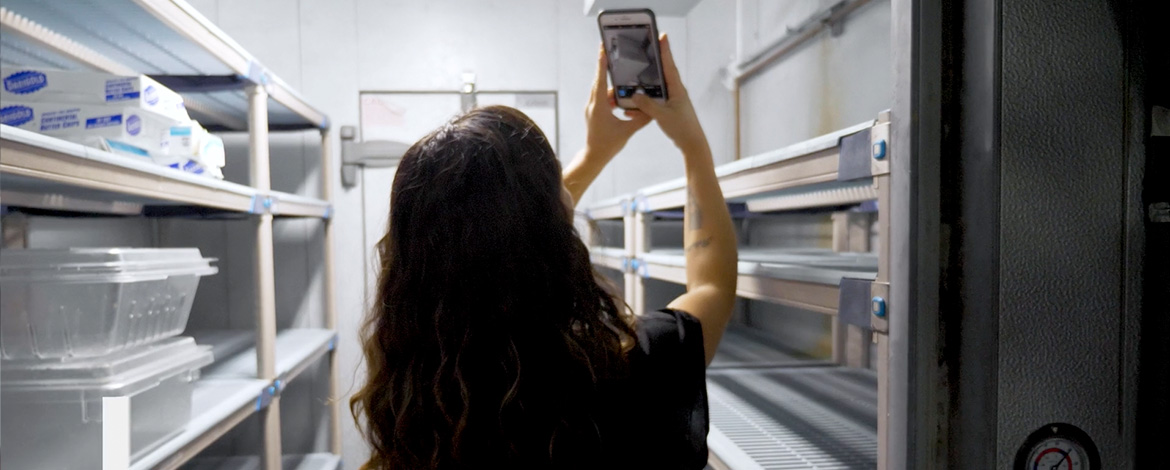
Knowing what the future holds
Every asset has a natural, four-stage lifecycle: Planning, Procurement, Operation/Maintenance and Disposal. Whether your restaurant’s kitchen is shiny and new, or you’re acquiring equipment that already has a few years on the odometer, each item is at some stage of this lifecycle.
If you’re in the early days of a small operation, you might be able to keep track in your head of what’s new, what’s old, and what’s being held together with duct tape. But when your business becomes multiple locations, with multiple kitchens, and you’re making significant investments in ovens, deep fryers, refrigeration, beverage dispensers and more, it can very quickly overwhelm any facilities management team.
A smart business has the foresight to consider the entire lifecycle before even moving beyond the planning phase. As you’re researching manufactures and considering which model is right for your needs, you should also be analyzing likely maintenance costs, the average lifespan of the asset, and what kind of daily wear-and-tear it will endure in your kitchen. As you move into procurement, it’s vital that you activate and track all warranties, have serial numbers and model identifiers at the ready, and that each asset is installed and powered properly. Then, as you move into the operation and maintenance stage, issues can be overcome quickly and efficiently — with information at your fingertips that will prevent duplicate service calls and costly ignorance of the asset’s warranty eligibility.
By predicting when an asset will reach its optimal peak performance and leaning into that window, you can calculate its depreciation value, ensure compliance with regulatory standards and most importantly, keep your business up and running.
Planning a repair and replacement budget
Unfortunately, breakdowns are every bit as unavoidable as death and taxes. At that point, a key question presents itself: Is it worthwhile to repair the asset? Or is it time for disposal and replacement?
This is one moment where, if you have good asset management software to back you up, you’ll be empowered to turn a crucial decision into an educated one. For starters, every breakdown is a learning opportunity. A CMMS platform should compile and analyze them, across all your locations, so you can answer questions like: What’s my most commonly-occurring problem? What’s my most expensive problem? Is one manufacturer brand outperforming another?
If you have Ecotrak as your facilities management software solution, it’s simply a matter of any authorized person in your company taking out their phone, opening the app and looking under Ecotrak’s proprietary “Decision Making Tool,” designed by restaurant and finance veterans with such a moment in mind. The tool displays personalized details about your asset, its original value and likely cost of a replacement. It also offers an estimated useful window of service (based on the hive-mind experiences of other users) and reminds you where yours is in that likely lifespan.
The “Decision Making Tool" or DMT — whose icon is a weight-balance scale, to underscore the plus/minus decision being weighed — then gives you a likely estimate for your repair, shows you how much you’ve spent already over the lifetime of the appliance, and offers an easy-to-read gauge system to make the choice even more transparent. If the needle is in the red, it’s likely time to replace; if you’re in the green, a repair is the more reasonable choice. But perhaps most helpful is the small yellow section, indicating that while you’re safe for now, it would be wise to begin setting aside funds for a replacement in the near future.
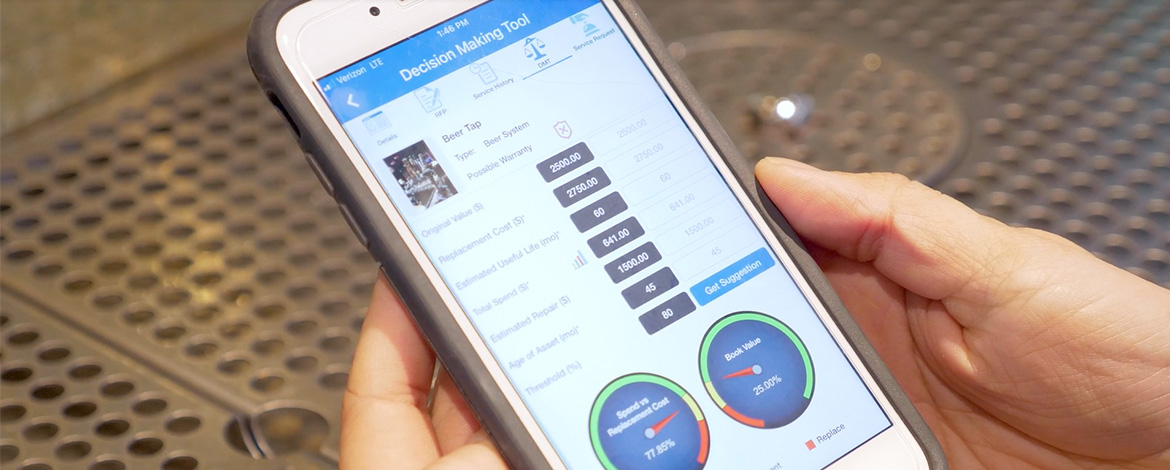
Facility management dependence
Whether you have dozens of locations, or simply dream of getting there someday, it is crucial that you monitor the lifecycles of your assets.
Ecotrak maintains information specific to the asset, then makes it available to both the customer and the service provider, enabling a smoother interaction. From manufacturer to model to serial number, to the ability to track warranties on three different levels (manufacturer, service provider and the often-overlooked component warranties), to documentation and saved photos of the actual equipment, everything is available on the app with a few swipes of a finger.
Another great tool is the custom flagging feature. Imagine if you or your management team could run a report for a designation such as “earmarked for replacement,” immediately pulling up every asset in your company approaching that final stage of the lifecycle. Keep in mind, this is real time information, provided up-to-the-minute by those you have designated at various locations. If a manager came in to find a broken dishwasher during the morning shift today, that could be on your report. This flag feature allows you to build your budget, anticipate work to come, and increase visibility and communication — and keep in mind, you can make as many flags as you need for subheadings like “inspection needed,” “ready to be cleaned” and more.
All this asset lifecycle information, of course, informs your company’s facility management efforts, and vice versa. With a company like Ecotrak, it’s all under one convenient umbrella, constantly updating data that you can view, adjust and share from your mobile device or desktop. So, if you want to see the problems costing the most money across your company, or the ones occurring most frequently, you can do so with precision; if you’d like to view your company’s spend by asset (who knew that maintaining the soft serve machine and grease trap costs as much as the HVAC?), or monitor which vendors are taking the most average days to complete a work order, all that information is similarly up-to-the-minute and ready for a deep-dive analysis.
The bottom line
When it comes to asset lifecycle management, you can either be driving the train or, if you’re not careful, get run over by it. Imagine all the considerations listed above, multiplied by a dozen locations — or a hundred, or a thousand. Whether you’re talking about Del Taco managing 300 corporate locations with their Ecotrak software, or other existing partners like Outback, Burger King and Lazy Dog, it’s easy to see why a software solution for overseeing your assets is a no-brainer.
INDUSTRY INSIGHT
What's Happening at Ecotrak
As your business shifts from no or low capacity to full capacity, it's time to review your hiring practices.
The COVID-19 pandemic had an enormous impact on nearly all areas of business, including your staffing. But now, capacity restrictions are beginning to ease.
While this is certainly good news for facilities, this new phase comes with its own challenges. Your next phase of re-opening? Staffing your facilities to meet new demand from your customers, in the middle of a hiring shortage.
If you are ready to ramp up your hiring for the upcoming season, it's worth examining your employment process. Here are eight hiring tips to start with as you prepare for full capacity.
1. Target your jobs postings
The vast majority of job candidates are now starting their job search online. While a digital job board means you may be able to reach a wider audience than before, this wide net can also be a challenge.
If your positions are in a niche area, like hospitality or retail, consider using industry trade publications, university job boards, or certain social channels to post your listings. You are actively recruiting candidates, so post your jobs to reach the best applicants where they are.
If you use large job sites, consider leveraging geo-targeting for your posts to get your listing in front of workers who live in your area. Local applicants may already be familiar with your business, or at the very least, a long commute won't be a discouraging factor.
2. Write descriptive job roles
Almost every single industry seems to be hiring right now. Why should someone choose to apply for your company?
Many facilities jobs can look similar on paper. The responsibilities may overlap significantly between similar positions at different companies. With this in mind, don't open a job description with just the bulleted list of responsibilities.
Instead, capture a candidate's attention by highlighting the strengths of your company. Talk about the culture and mission. Leverage current team member testimonials or descriptions. Make it clear to a potential applicant why they would love to work with your company before you go into the details of the role.
Next, although you want to be creative in describing your business, make sure to still optimize your posting for what candidates are searching for. While "mixologist" may sound exciting to you, the perfect candidate may be searching the common word, "bartender". Use the most common and simple job title for an open position.
Finally, make sure that you include a salary or wage range for your postings. It's a competitive hiring field right now, so being upfront can be an advantage. Avoid general phrases like "plus tips" or "signing bonus." When candidates know that your wages will cover their cost of living, they will be more likely to apply.
3. Look for ambition, not just experience
In today's hiring shortage, you may not be able to find candidates with every single skill that you need for the role. However, ambitious applicants can usually learn the skill sets required. When interviewing for a role, look beyond an applicant's on-paper job experience to see their potential. While this will require investing in employee training, it is also an opportunity to teach an employee the exact skills they need for your company.
In addition, if you have found a candidate who is a good fit for a role, don't wait to make the job offer. Most job applicants are applying to multiple places at once, and in today's labor crunch, they may receive other job offers quickly. If you find someone who is a good fit, consider making the job offer as soon as possible—potentially on the spot, or within 24 hours.
4. Feature a professional career page
Potential candidates aren't just looking for a job; they are looking for a career. Let them know that they've found the right place. Communicate that working with your company isn't just an hourly opportunity, but an opportunity for career advancement.
Showcase this career path prominently on your website with a "careers" page. Make this commitment obvious by naming the page Careers, not Hiring or Jobs.
Use the page to show potential applicants how you invest in employees and encourage retention, as well as what job perks and benefits you offer. It's also an opportunity to demonstrate what your team culture looks like and how you celebrate current employees.
5. Prioritize assessments and pre-screen questions
If you are ramping up your hiring for the foreseeable future, an Applicant Tracking System (ATS) can help streamline the process and keep it easy for both your hiring managers and applicants. Many managers know the struggle of scheduling multiple interviews and discover that most people don't show up.
Using assessments and pre-screen questions through your ATS can help ensure that only the most committed applicants are moved through to the interview round. With these questionnaires, you can not only assess the skill levels of applicants, but you can also see who is more likely to follow through. When applicants take the effort to go through these extra steps, you know they are much more likely to show up and engage in your in-person interviews.
For the applicant, these assessments and pre-screen questions can serve to become invested in the role and see that a facility is taking the hiring process seriously.
6. Champion diversity and inclusion
Diverse, inclusive teams are talented teams. Work toward your diversity and inclusion goals by using what resources you have, like your applicant tracking system.
If your ATS meets diversity and inclusion standards, it can help your management create a repeatable, thorough evaluation process. Interviewers can use the ATS to rate candidates based on the same consistent framework. With these metrics in hand, your managers can compare applicants on equal terms during the hiring process.
7. Focus on retention
If your business demand is growing again, it's inevitable that you will need to do more hiring. However, in the rush to hire new employees, make sure that you don't forget to prioritize retention of existing staff as well.
All employers know that high turnover is costly. When you need to fill an open position, you must recruit, hire, onboard, train, and go through a period of employee development. If you cannot fill the open position right away, you also have the cost of operating your facility with an unfilled team role, which can be difficult for your existing staff and affect customer service.
To avoid this cost as much as possible, examine your retention track record. Traditionally, retention tactics commonly center around increased pay, adding benefits, and career advancement opportunities. While these should still be a focus, you may want to go even further.
The past year has been difficult for workers and companies alike. Consider examining your company's accountability, flexibility, and investment in employees, and how these policies may impact retention.
Your company culture affects retention, for both your current employees and any future ones. The goal? To have your current staff telling their friends and family what a great place your company is to work.
8. Consider implementing a referral bonus
Finally, alongside retention, consider using your current staff as recruiters to help you find new applicants. Current employees can be an asset to help you attract quality applicants. A referral program can get everyone involved in the recruiting process.
Before implementing the program, make sure to communicate to employees why you are working with them for referrals: because you want more employees like them. If your staff feels invested, they will likely be more helpful in your referral search.
Of course, your referral program should also include a referral bonus as incentive. Make the bonus large enough to matter (something no less than $250) and pay it quickly (no less than 90 days). Making the bonus meaningful and timely can help your staff understand the beneficial impact of a great referral.
Conclusion
As business ramps up to full capacity, it's more important than ever to invest in quality recruitment and retention. With these tips in mind, you can be better prepared to meet the challenges of full staffing once again.
Restaurant365 incorporates restaurant accounting software, restaurant operations software, inventory management software, payroll + HR software, and scheduling software into a cloud-based platform. R365 HIRE makes it easy for you to filter, hire and onboard the optimal employees for your business.
INDUSTRY INSIGHT
What's Happening at Ecotrak
As the chaotic year of 2020 comes to a close, this is the perfect time to take a deeper look at the state of your financials. A better understanding of where your books are now will help you set next year’s business goals and set yourself up for financial success in 2021.
We teamed up with our friends at One Point Accounting, an accounting company that exclusively serves restaurant franchises, to share the five cash management and accounting areas that can have a big impact on your profits and as you close out 2020.
1. Inventory Management
Inventory management is an important component of any cash flow strategy. Inventory is cash already spent. Having too little on hand impacts how much you can sell, and having too much on hand impacts what else you can buy. Consistent accounting practices help identify patterns in your business’s cash management and lead to more accurate forecasting.
That being said, restaurant inventory management can be time consuming and challenging to do well. But it’s also critical for both the day-to-day financial health of your business and for informing your long-term business strategy.
The easiest way to keep your inventory accurate and up to date is to make it as easy as possible for yourself and your team. Since inventory can be tedious to do by hand on an inventory sheet, investigate using your POS, reusable templates, or a platform with a mobile app that can streamline weekly inventory management. The most important thing is to create a standard process that is replicable and sustainable whether weekly or monthly. Instilling this discipline and ensuring your staff is well trained and following through will pay dividends in the future. Proper inventory management can have a big impact on the financial bottom line of your business.
2. Cash Over Short
Do you know all the stories your accounting data can tell?
Discrepancies in your cash over short account can help identify training deficiencies, QA issues, vendor errors, or even theft. Noticing and investigating when funds don't add up can help your units save thousands of dollars.
Examining point of sale records and deposit records side by side with the bank statement is the first step in affirming your accounting processes are working as they should. This singular step uncovers over a third of the discrepancies.
3. Staffing
Much like inventory management, staffing is a critical part of optimizing your monthly cash flow. Having the ability to quickly analyze labor costs and identify opportunities to increase or decrease staffing based on peak and non-peak hours is essential. In addition, access to data to benchmark those labor costs in comparison to your peers can be incredibly valuable.
4. Forecasting & Maintaining Current Financials
Maintaining real-time financial reporting lets you make decisions faster, reducing failure rates and improving business operations. Accurate forecasting can help you reduce waste and maximize profits. It's time to look at how appropriately you've been predicting sales and stocking your inventory. Review your accounting data to help you predict trends and plan ahead.
The good news is, making your accounting data actionable isn’t actually that complicated. You already have all the numbers you need and you don’t need data analysts or expensive software to make it actionable. Regularly taking a look at your financial analytics and tracking the same numbers over time will give you historical insight to allow you to set a baseline, identify trends, and give you actionable insight to make better business decisions.
5. Get an Accounting Partner
Bottom line? You are responsible for creating strong financial systems and processes for verifying your deposits, invoices and transactions. And it can be overwhelming to find the time to review all of these important documents and successfully run the other aspects of your business at the same time.
A good accounting partner will be experts in the business and accounting challenges you face and know how critical reliable accounting data is to your business. A good accounting vendor will provide that second set of eyes on your data to help you avoid costly errors, identify cash management opportunities, and give you more comprehensive insight into your business’s performance.
If you’re a franchisee or franchisor in need of an accounting solution, contact OnePoint for a free consultation.
